Project Management: Key Differences, IRR, Enthusiasm, Budgets
VerifiedAdded on 2022/08/20
|21
|5564
|12
Homework Assignment
AI Summary
This document provides comprehensive solutions to a project management assessment. It begins by differentiating between projects and processes, highlighting their distinct purposes, importance, duration, focus, and positioning within an organization. The document then delves into the concept of Internal Rate of Return (IRR), outlining its advantages and disadvantages in evaluating projects. Furthermore, it explores strategies for project managers to foster enthusiasm within project teams, detailing the stages of group development (Forming, Storming, Norming, Performing, and Adjourning) and the corresponding project management behaviors exhibited in each stage. The document also explains the creation of top-down and bottom-up budgets, comparing the advantages of each approach. Finally, it addresses resource scheduling in a multi-project environment, providing common heuristics and examples to optimize resource allocation and project timelines. Overall, the document is a comprehensive resource for understanding and applying core project management principles.
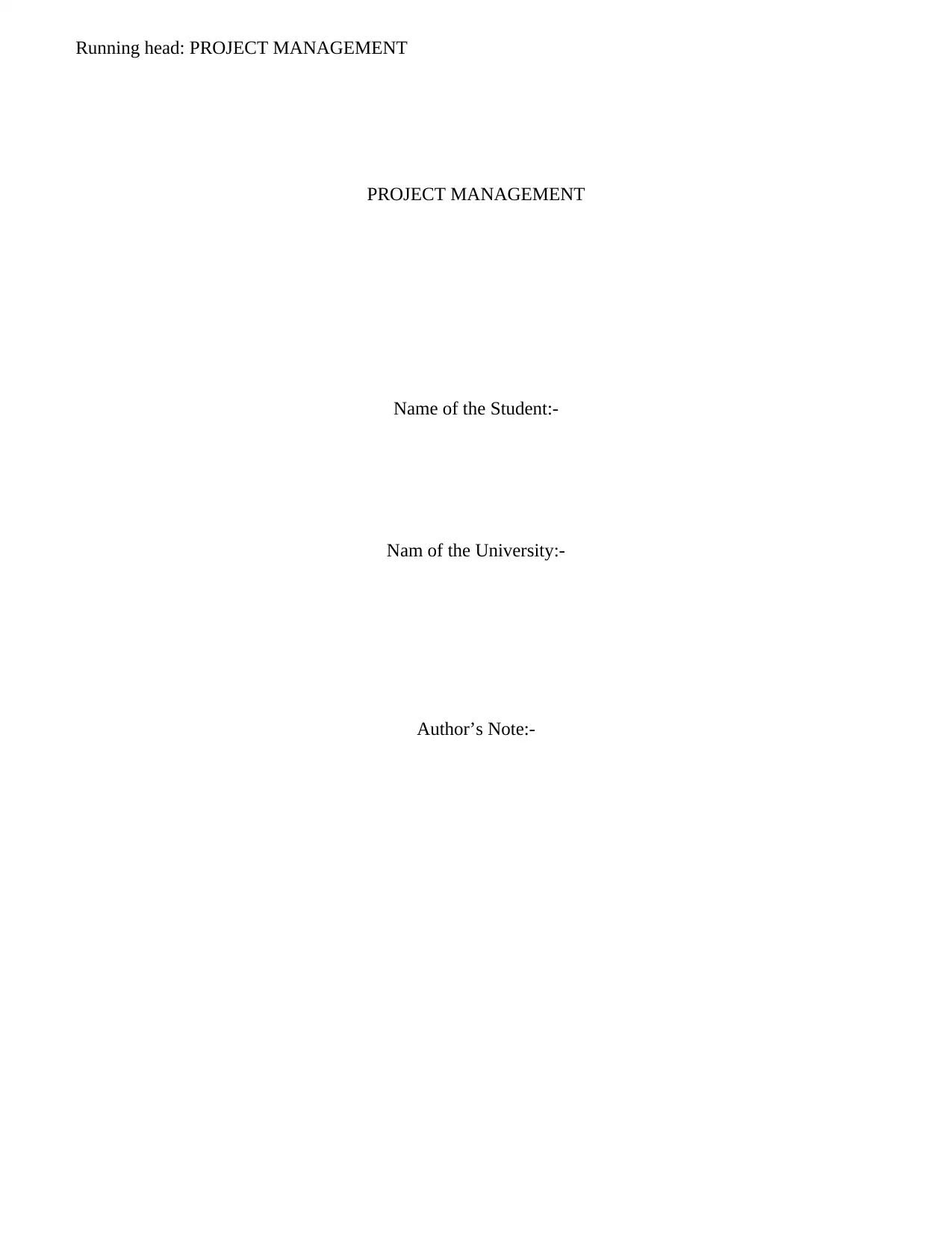
Running head: PROJECT MANAGEMENT
PROJECT MANAGEMENT
Name of the Student:-
Nam of the University:-
Author’s Note:-
PROJECT MANAGEMENT
Name of the Student:-
Nam of the University:-
Author’s Note:-
Paraphrase This Document
Need a fresh take? Get an instant paraphrase of this document with our AI Paraphraser
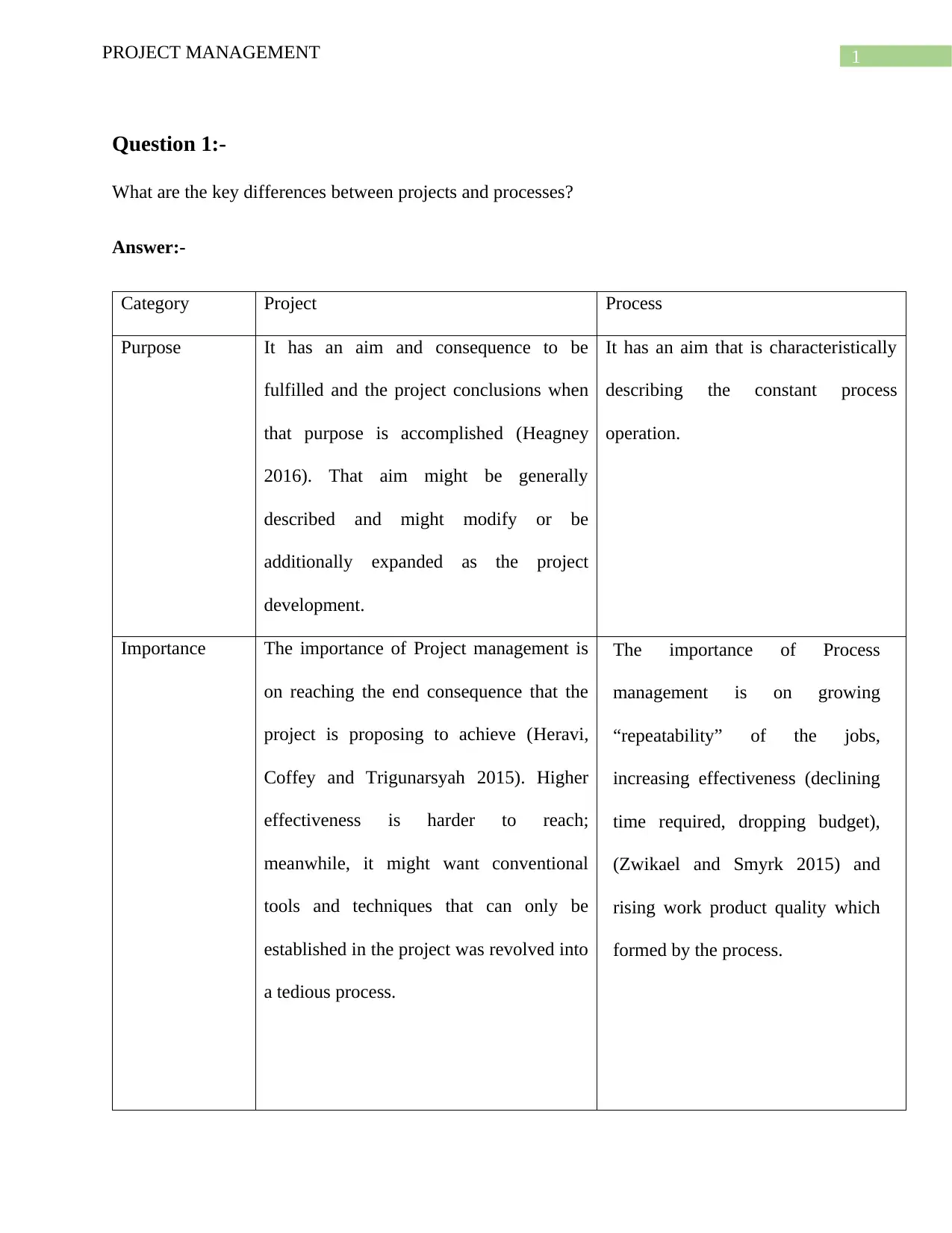
1PROJECT MANAGEMENT
Question 1:-
What are the key differences between projects and processes?
Answer:-
Category Project Process
Purpose It has an aim and consequence to be
fulfilled and the project conclusions when
that purpose is accomplished (Heagney
2016). That aim might be generally
described and might modify or be
additionally expanded as the project
development.
It has an aim that is characteristically
describing the constant process
operation.
Importance The importance of Project management is
on reaching the end consequence that the
project is proposing to achieve (Heravi,
Coffey and Trigunarsyah 2015). Higher
effectiveness is harder to reach;
meanwhile, it might want conventional
tools and techniques that can only be
established in the project was revolved into
a tedious process.
The importance of Process
management is on growing
“repeatability” of the jobs,
increasing effectiveness (declining
time required, dropping budget),
(Zwikael and Smyrk 2015) and
rising work product quality which
formed by the process.
Question 1:-
What are the key differences between projects and processes?
Answer:-
Category Project Process
Purpose It has an aim and consequence to be
fulfilled and the project conclusions when
that purpose is accomplished (Heagney
2016). That aim might be generally
described and might modify or be
additionally expanded as the project
development.
It has an aim that is characteristically
describing the constant process
operation.
Importance The importance of Project management is
on reaching the end consequence that the
project is proposing to achieve (Heravi,
Coffey and Trigunarsyah 2015). Higher
effectiveness is harder to reach;
meanwhile, it might want conventional
tools and techniques that can only be
established in the project was revolved into
a tedious process.
The importance of Process
management is on growing
“repeatability” of the jobs,
increasing effectiveness (declining
time required, dropping budget),
(Zwikael and Smyrk 2015) and
rising work product quality which
formed by the process.

2PROJECT MANAGEMENT
Duration
It has a starting and conclusion (while the
opening and conclusion may not be well
described when the project starts and the
finish might be a considerable time in the
upcoming time).
It is usually continuing and does not
usually have a finish.
Focus The focus of there is on handling a project
characteristically using some procedure in
reaching some process of the anticipated
end outcome (Galvan et al. 2015). Every
project monitors a certain kind of
procedure; however, it may not be
appropriately defined.
The focus is on management a process
like as a product development process.
Like a procedure might be applied
across a variability of projects. These
might involve specific project
management to describe and expand
the process.
Positioning The categorization of responsibilities in a
"project" is not usually repetitive and may
not be recognized at the beginning of the
project.
There is a repetitive arrangement of
responsibilities, and the tasks are
recognized at the beginning from the
time when it is repetitive
(Kermanshachi et al. 2017).
Overall Concept Project is on handling some category of
modification in the technique an industry
activates to create the general business
operate more efficiently.
The process to cope with present
business developments as
professionally and efficiently as
possible.
Duration
It has a starting and conclusion (while the
opening and conclusion may not be well
described when the project starts and the
finish might be a considerable time in the
upcoming time).
It is usually continuing and does not
usually have a finish.
Focus The focus of there is on handling a project
characteristically using some procedure in
reaching some process of the anticipated
end outcome (Galvan et al. 2015). Every
project monitors a certain kind of
procedure; however, it may not be
appropriately defined.
The focus is on management a process
like as a product development process.
Like a procedure might be applied
across a variability of projects. These
might involve specific project
management to describe and expand
the process.
Positioning The categorization of responsibilities in a
"project" is not usually repetitive and may
not be recognized at the beginning of the
project.
There is a repetitive arrangement of
responsibilities, and the tasks are
recognized at the beginning from the
time when it is repetitive
(Kermanshachi et al. 2017).
Overall Concept Project is on handling some category of
modification in the technique an industry
activates to create the general business
operate more efficiently.
The process to cope with present
business developments as
professionally and efficiently as
possible.
⊘ This is a preview!⊘
Do you want full access?
Subscribe today to unlock all pages.

Trusted by 1+ million students worldwide

3PROJECT MANAGEMENT
Question 2:-
What is an internal rate of return and what advantages and disadvantages are accrued by using it
to evaluate projects?
Answer:-
This is a calculation of a speculation’s amount of return. The word internal mentions to
the detail that the calculation rejects external features, like as the hazard free rate, price rises, the
cost of money, or several monetary risks (Gabriel Filho et al. 2016). It is constant for funds of
changing types and, as such, IRR this can be executed to rank multiple approaching projects on a
comparatively even basis.
Suppose the same budgets apply for different works, then the project with the maximum
IRR will be designated. If a business wants to select between several investments possibilities
where the cost of speculation remains continuous, then IRR will be applied to standard the
projects and choose the most commercial one.
Advantages:-
It is calculated by measuring the interest rate at which the current rate of upcoming cash
flows matches the mandatory money venture (Bhuller, Mogstad and Salvanes 2017). The
advantage is that the effectiveness of cash flows in all upcoming centuries are measured and,
consequently, every cash flow is assumed equivalent weight by expending the time importance
of money.
It delivers any small commercial owner with a rapid snapshot of what first projects would
deliver the extreme possible cash flow. It can also be applying for accounting purposes like as to
Question 2:-
What is an internal rate of return and what advantages and disadvantages are accrued by using it
to evaluate projects?
Answer:-
This is a calculation of a speculation’s amount of return. The word internal mentions to
the detail that the calculation rejects external features, like as the hazard free rate, price rises, the
cost of money, or several monetary risks (Gabriel Filho et al. 2016). It is constant for funds of
changing types and, as such, IRR this can be executed to rank multiple approaching projects on a
comparatively even basis.
Suppose the same budgets apply for different works, then the project with the maximum
IRR will be designated. If a business wants to select between several investments possibilities
where the cost of speculation remains continuous, then IRR will be applied to standard the
projects and choose the most commercial one.
Advantages:-
It is calculated by measuring the interest rate at which the current rate of upcoming cash
flows matches the mandatory money venture (Bhuller, Mogstad and Salvanes 2017). The
advantage is that the effectiveness of cash flows in all upcoming centuries are measured and,
consequently, every cash flow is assumed equivalent weight by expending the time importance
of money.
It delivers any small commercial owner with a rapid snapshot of what first projects would
deliver the extreme possible cash flow. It can also be applying for accounting purposes like as to
Paraphrase This Document
Need a fresh take? Get an instant paraphrase of this document with our AI Paraphraser

4PROJECT MANAGEMENT
deliver a rapid snapshot of the potential value or savings of buying different apparatus as
contrasting to renovating outdated equipment.
This process can be a particular amount and usually ends up as an irregular approximation. The
IRR technique does not necessitate the problem rate, mitigating the threat of determining an
incorrect rate. When the IRR is considered, projects can be designated where the IRR outstrips
the projected cost of wealth.
Disadvantages:-
A drawback of using the IRR technique is that it does not describe for the project size
when linking projects. Cash flows are just comparing to the sum of capital expense, making
those cash flows. These can be difficult when two projects need expressively several amounts of
capital expense, but the minor project returns a higher IRR.
The IRR method only worries itself with the predictable cash flows created by an
investment injection and ignores the feasible future budgets that may affect revenue. If the user
sees a venture in Lorries, for instance, upcoming fuel and preservation prices might affect
income as fuel prices vary and maintenance necessities change. A dependent project may be the
essential to obtaining unoccupied land on which to park all trucks, and such charge would not
factor in the IRR measurement of the cash flows made by the procedure of the fleet.
While the IRR permits the user to calculate the worth of upcoming cash flows, it creates
an inherent notion that those cash flows can be invested at a similar rate as the IRR
(Mohammadtalebi, Jahangiri and Eshghiaraghi 2018). That statement is not applied as the IRR is
occasionally a very high amount and predictions that yield such a return are generally not
accessible or significantly restricted.
deliver a rapid snapshot of the potential value or savings of buying different apparatus as
contrasting to renovating outdated equipment.
This process can be a particular amount and usually ends up as an irregular approximation. The
IRR technique does not necessitate the problem rate, mitigating the threat of determining an
incorrect rate. When the IRR is considered, projects can be designated where the IRR outstrips
the projected cost of wealth.
Disadvantages:-
A drawback of using the IRR technique is that it does not describe for the project size
when linking projects. Cash flows are just comparing to the sum of capital expense, making
those cash flows. These can be difficult when two projects need expressively several amounts of
capital expense, but the minor project returns a higher IRR.
The IRR method only worries itself with the predictable cash flows created by an
investment injection and ignores the feasible future budgets that may affect revenue. If the user
sees a venture in Lorries, for instance, upcoming fuel and preservation prices might affect
income as fuel prices vary and maintenance necessities change. A dependent project may be the
essential to obtaining unoccupied land on which to park all trucks, and such charge would not
factor in the IRR measurement of the cash flows made by the procedure of the fleet.
While the IRR permits the user to calculate the worth of upcoming cash flows, it creates
an inherent notion that those cash flows can be invested at a similar rate as the IRR
(Mohammadtalebi, Jahangiri and Eshghiaraghi 2018). That statement is not applied as the IRR is
occasionally a very high amount and predictions that yield such a return are generally not
accessible or significantly restricted.
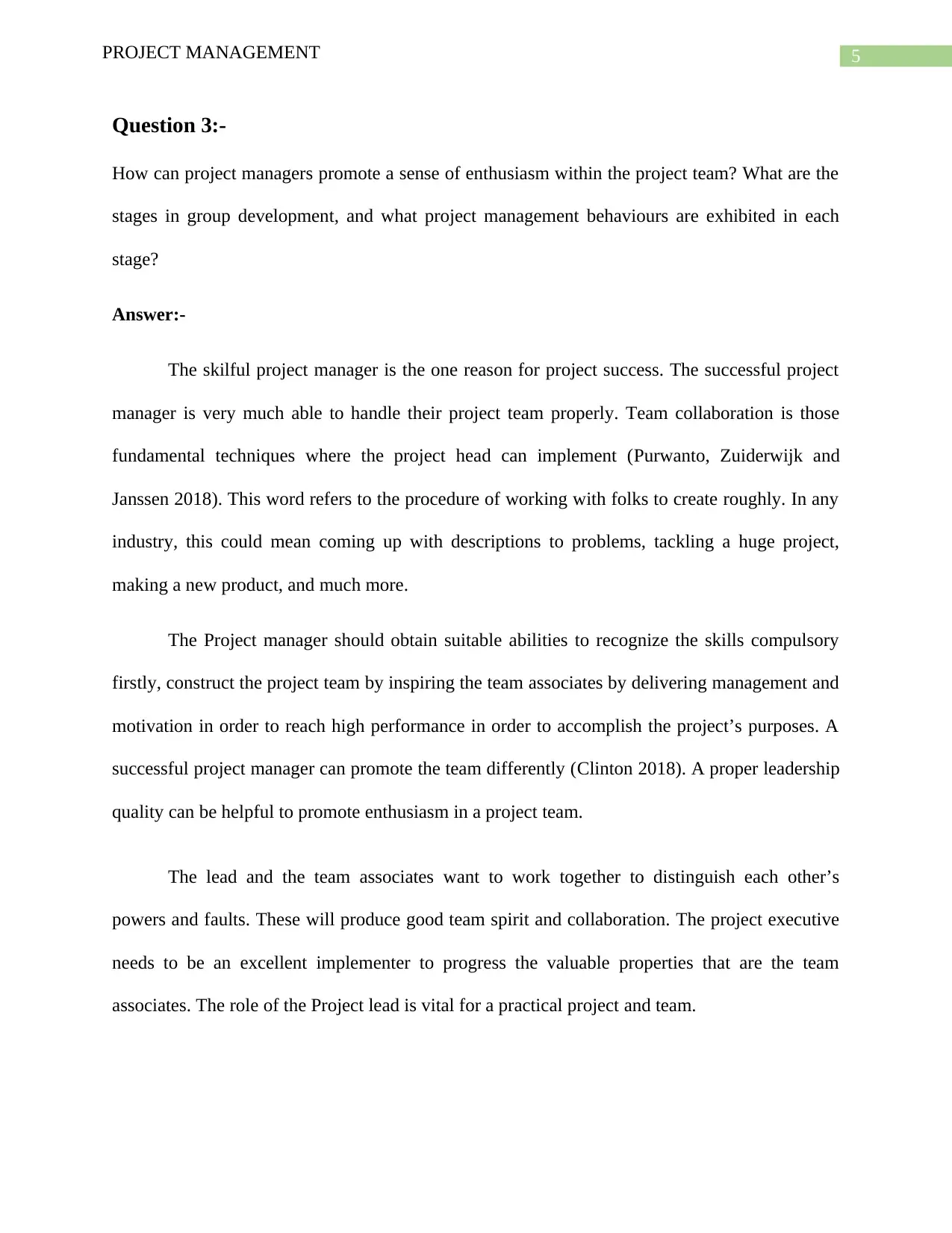
5PROJECT MANAGEMENT
Question 3:-
How can project managers promote a sense of enthusiasm within the project team? What are the
stages in group development, and what project management behaviours are exhibited in each
stage?
Answer:-
The skilful project manager is the one reason for project success. The successful project
manager is very much able to handle their project team properly. Team collaboration is those
fundamental techniques where the project head can implement (Purwanto, Zuiderwijk and
Janssen 2018). This word refers to the procedure of working with folks to create roughly. In any
industry, this could mean coming up with descriptions to problems, tackling a huge project,
making a new product, and much more.
The Project manager should obtain suitable abilities to recognize the skills compulsory
firstly, construct the project team by inspiring the team associates by delivering management and
motivation in order to reach high performance in order to accomplish the project’s purposes. A
successful project manager can promote the team differently (Clinton 2018). A proper leadership
quality can be helpful to promote enthusiasm in a project team.
The lead and the team associates want to work together to distinguish each other’s
powers and faults. These will produce good team spirit and collaboration. The project executive
needs to be an excellent implementer to progress the valuable properties that are the team
associates. The role of the Project lead is vital for a practical project and team.
Question 3:-
How can project managers promote a sense of enthusiasm within the project team? What are the
stages in group development, and what project management behaviours are exhibited in each
stage?
Answer:-
The skilful project manager is the one reason for project success. The successful project
manager is very much able to handle their project team properly. Team collaboration is those
fundamental techniques where the project head can implement (Purwanto, Zuiderwijk and
Janssen 2018). This word refers to the procedure of working with folks to create roughly. In any
industry, this could mean coming up with descriptions to problems, tackling a huge project,
making a new product, and much more.
The Project manager should obtain suitable abilities to recognize the skills compulsory
firstly, construct the project team by inspiring the team associates by delivering management and
motivation in order to reach high performance in order to accomplish the project’s purposes. A
successful project manager can promote the team differently (Clinton 2018). A proper leadership
quality can be helpful to promote enthusiasm in a project team.
The lead and the team associates want to work together to distinguish each other’s
powers and faults. These will produce good team spirit and collaboration. The project executive
needs to be an excellent implementer to progress the valuable properties that are the team
associates. The role of the Project lead is vital for a practical project and team.
⊘ This is a preview!⊘
Do you want full access?
Subscribe today to unlock all pages.

Trusted by 1+ million students worldwide
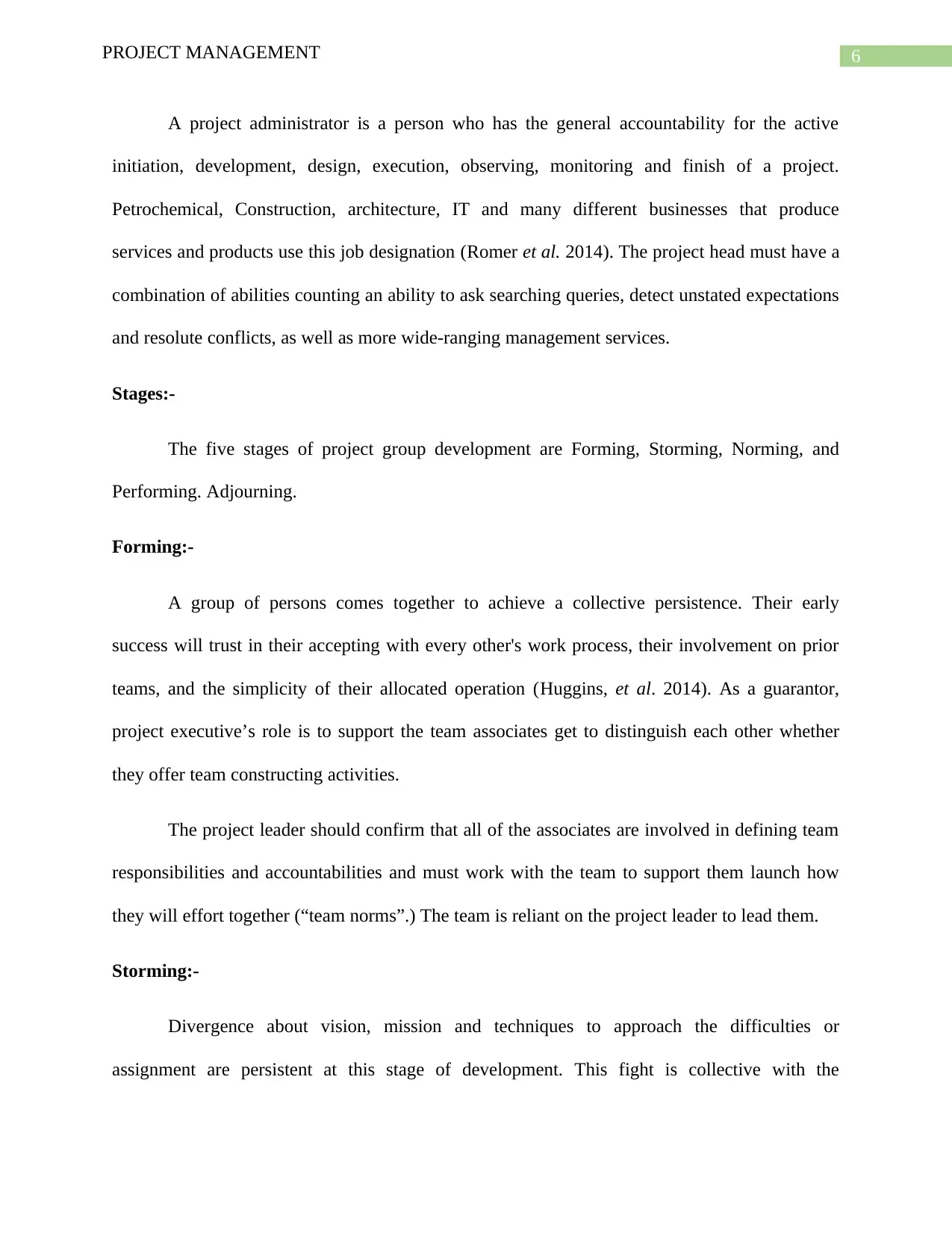
6PROJECT MANAGEMENT
A project administrator is a person who has the general accountability for the active
initiation, development, design, execution, observing, monitoring and finish of a project.
Petrochemical, Construction, architecture, IT and many different businesses that produce
services and products use this job designation (Romer et al. 2014). The project head must have a
combination of abilities counting an ability to ask searching queries, detect unstated expectations
and resolute conflicts, as well as more wide-ranging management services.
Stages:-
The five stages of project group development are Forming, Storming, Norming, and
Performing. Adjourning.
Forming:-
A group of persons comes together to achieve a collective persistence. Their early
success will trust in their accepting with every other's work process, their involvement on prior
teams, and the simplicity of their allocated operation (Huggins, et al. 2014). As a guarantor,
project executive’s role is to support the team associates get to distinguish each other whether
they offer team constructing activities.
The project leader should confirm that all of the associates are involved in defining team
responsibilities and accountabilities and must work with the team to support them launch how
they will effort together (“team norms”.) The team is reliant on the project leader to lead them.
Storming:-
Divergence about vision, mission and techniques to approach the difficulties or
assignment are persistent at this stage of development. This fight is collective with the
A project administrator is a person who has the general accountability for the active
initiation, development, design, execution, observing, monitoring and finish of a project.
Petrochemical, Construction, architecture, IT and many different businesses that produce
services and products use this job designation (Romer et al. 2014). The project head must have a
combination of abilities counting an ability to ask searching queries, detect unstated expectations
and resolute conflicts, as well as more wide-ranging management services.
Stages:-
The five stages of project group development are Forming, Storming, Norming, and
Performing. Adjourning.
Forming:-
A group of persons comes together to achieve a collective persistence. Their early
success will trust in their accepting with every other's work process, their involvement on prior
teams, and the simplicity of their allocated operation (Huggins, et al. 2014). As a guarantor,
project executive’s role is to support the team associates get to distinguish each other whether
they offer team constructing activities.
The project leader should confirm that all of the associates are involved in defining team
responsibilities and accountabilities and must work with the team to support them launch how
they will effort together (“team norms”.) The team is reliant on the project leader to lead them.
Storming:-
Divergence about vision, mission and techniques to approach the difficulties or
assignment are persistent at this stage of development. This fight is collective with the
Paraphrase This Document
Need a fresh take? Get an instant paraphrase of this document with our AI Paraphraser

7PROJECT MANAGEMENT
circumstance that team associates are still receiving to identify each other, learning to effort with
each other, and increasing accustomed to the communication and interaction of group associates.
As a benefactor, help project team leader explains each of these projects so that the group
succeeds. Generally, teams included members who are skillfully undeveloped will have an
uncertain time receiving past this phase.
Norming:-
The group has intentionally or instinctively formed working relations that are permitting
development on the team’s purposes. The associates have intentionally or unconsciously
arranged to stand by exact set norms, and they are becoming beneficial at functioning together.
As a guarantor, ask for interrupted updates from the project group (Pillai 2014). Commonly
check the team's development at agreed-upon intermissions and critical phases on the path to a
valid conclusion.
The project leader might not be as involved in choice making and problem explaining
since the team associates are working better together and can take on more accountability in
these regions. The team has better self-direction and is capable of resolving concerns and conflict
as a group.
Performing:-
Relations, team measures, and the team’s effectiveness in functioning on its purposes are
syncing to carry about an effectively operational team. This is the phase at which the actual work
of the team is developing. As a guarantor, ask for interrupted updates from the project group.
Make to Confirm that team associates are communicating with every of the other suitable parties
in the office.
circumstance that team associates are still receiving to identify each other, learning to effort with
each other, and increasing accustomed to the communication and interaction of group associates.
As a benefactor, help project team leader explains each of these projects so that the group
succeeds. Generally, teams included members who are skillfully undeveloped will have an
uncertain time receiving past this phase.
Norming:-
The group has intentionally or instinctively formed working relations that are permitting
development on the team’s purposes. The associates have intentionally or unconsciously
arranged to stand by exact set norms, and they are becoming beneficial at functioning together.
As a guarantor, ask for interrupted updates from the project group (Pillai 2014). Commonly
check the team's development at agreed-upon intermissions and critical phases on the path to a
valid conclusion.
The project leader might not be as involved in choice making and problem explaining
since the team associates are working better together and can take on more accountability in
these regions. The team has better self-direction and is capable of resolving concerns and conflict
as a group.
Performing:-
Relations, team measures, and the team’s effectiveness in functioning on its purposes are
syncing to carry about an effectively operational team. This is the phase at which the actual work
of the team is developing. As a guarantor, ask for interrupted updates from the project group.
Make to Confirm that team associates are communicating with every of the other suitable parties
in the office.
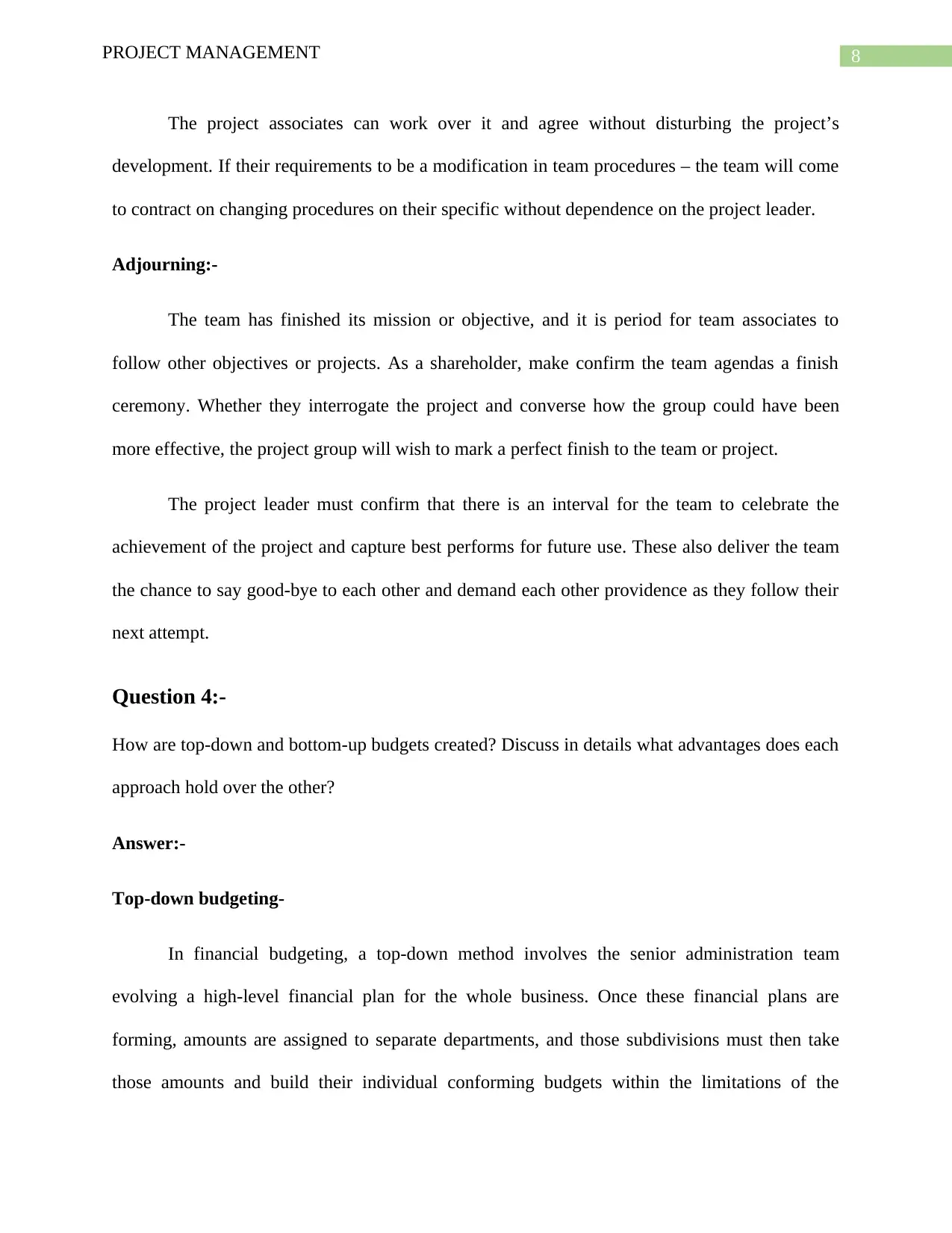
8PROJECT MANAGEMENT
The project associates can work over it and agree without disturbing the project’s
development. If their requirements to be a modification in team procedures – the team will come
to contract on changing procedures on their specific without dependence on the project leader.
Adjourning:-
The team has finished its mission or objective, and it is period for team associates to
follow other objectives or projects. As a shareholder, make confirm the team agendas a finish
ceremony. Whether they interrogate the project and converse how the group could have been
more effective, the project group will wish to mark a perfect finish to the team or project.
The project leader must confirm that there is an interval for the team to celebrate the
achievement of the project and capture best performs for future use. These also deliver the team
the chance to say good-bye to each other and demand each other providence as they follow their
next attempt.
Question 4:-
How are top-down and bottom-up budgets created? Discuss in details what advantages does each
approach hold over the other?
Answer:-
Top-down budgeting-
In financial budgeting, a top-down method involves the senior administration team
evolving a high-level financial plan for the whole business. Once these financial plans are
forming, amounts are assigned to separate departments, and those subdivisions must then take
those amounts and build their individual conforming budgets within the limitations of the
The project associates can work over it and agree without disturbing the project’s
development. If their requirements to be a modification in team procedures – the team will come
to contract on changing procedures on their specific without dependence on the project leader.
Adjourning:-
The team has finished its mission or objective, and it is period for team associates to
follow other objectives or projects. As a shareholder, make confirm the team agendas a finish
ceremony. Whether they interrogate the project and converse how the group could have been
more effective, the project group will wish to mark a perfect finish to the team or project.
The project leader must confirm that there is an interval for the team to celebrate the
achievement of the project and capture best performs for future use. These also deliver the team
the chance to say good-bye to each other and demand each other providence as they follow their
next attempt.
Question 4:-
How are top-down and bottom-up budgets created? Discuss in details what advantages does each
approach hold over the other?
Answer:-
Top-down budgeting-
In financial budgeting, a top-down method involves the senior administration team
evolving a high-level financial plan for the whole business. Once these financial plans are
forming, amounts are assigned to separate departments, and those subdivisions must then take
those amounts and build their individual conforming budgets within the limitations of the
⊘ This is a preview!⊘
Do you want full access?
Subscribe today to unlock all pages.

Trusted by 1+ million students worldwide
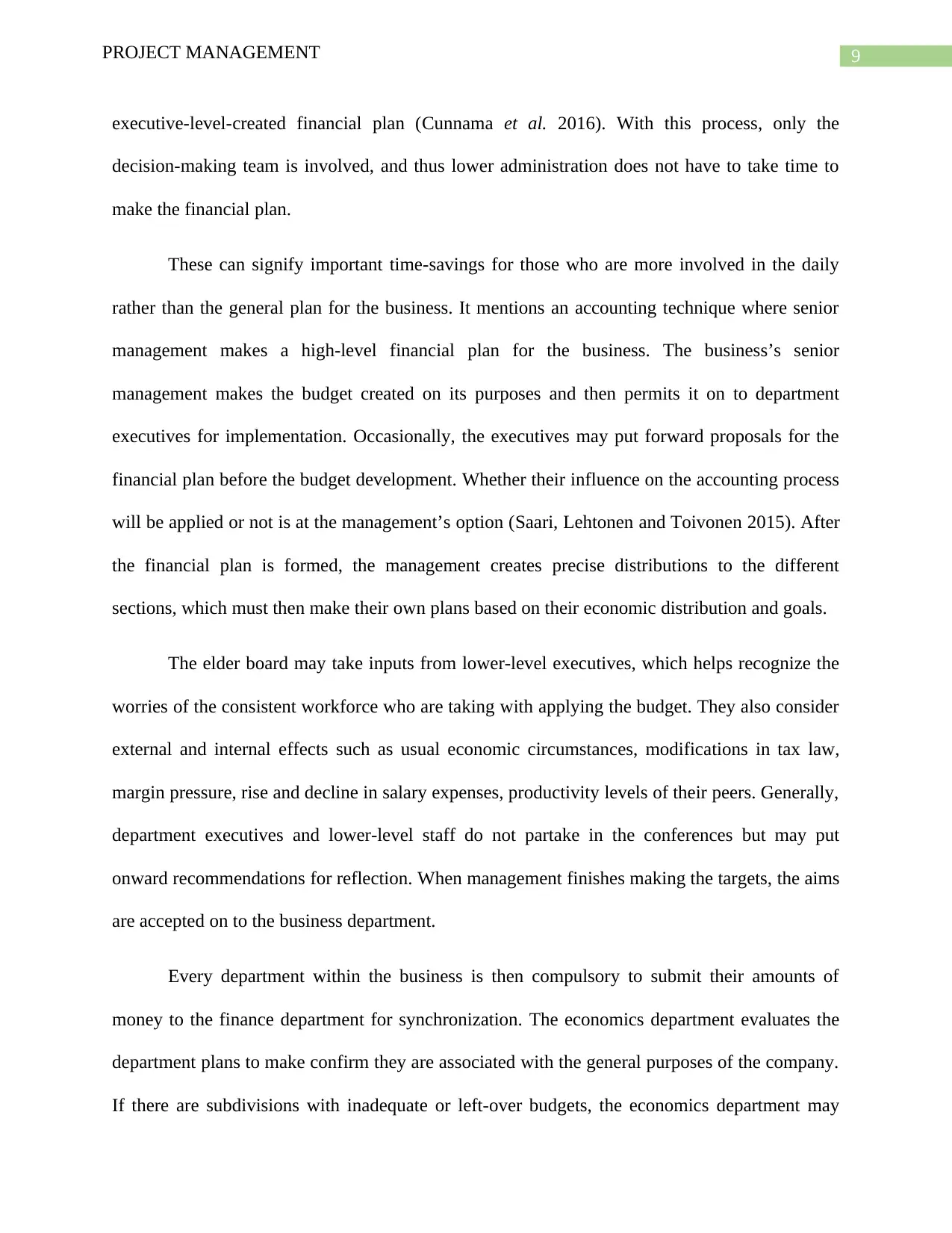
9PROJECT MANAGEMENT
executive-level-created financial plan (Cunnama et al. 2016). With this process, only the
decision-making team is involved, and thus lower administration does not have to take time to
make the financial plan.
These can signify important time-savings for those who are more involved in the daily
rather than the general plan for the business. It mentions an accounting technique where senior
management makes a high-level financial plan for the business. The business’s senior
management makes the budget created on its purposes and then permits it on to department
executives for implementation. Occasionally, the executives may put forward proposals for the
financial plan before the budget development. Whether their influence on the accounting process
will be applied or not is at the management’s option (Saari, Lehtonen and Toivonen 2015). After
the financial plan is formed, the management creates precise distributions to the different
sections, which must then make their own plans based on their economic distribution and goals.
The elder board may take inputs from lower-level executives, which helps recognize the
worries of the consistent workforce who are taking with applying the budget. They also consider
external and internal effects such as usual economic circumstances, modifications in tax law,
margin pressure, rise and decline in salary expenses, productivity levels of their peers. Generally,
department executives and lower-level staff do not partake in the conferences but may put
onward recommendations for reflection. When management finishes making the targets, the aims
are accepted on to the business department.
Every department within the business is then compulsory to submit their amounts of
money to the finance department for synchronization. The economics department evaluates the
department plans to make confirm they are associated with the general purposes of the company.
If there are subdivisions with inadequate or left-over budgets, the economics department may
executive-level-created financial plan (Cunnama et al. 2016). With this process, only the
decision-making team is involved, and thus lower administration does not have to take time to
make the financial plan.
These can signify important time-savings for those who are more involved in the daily
rather than the general plan for the business. It mentions an accounting technique where senior
management makes a high-level financial plan for the business. The business’s senior
management makes the budget created on its purposes and then permits it on to department
executives for implementation. Occasionally, the executives may put forward proposals for the
financial plan before the budget development. Whether their influence on the accounting process
will be applied or not is at the management’s option (Saari, Lehtonen and Toivonen 2015). After
the financial plan is formed, the management creates precise distributions to the different
sections, which must then make their own plans based on their economic distribution and goals.
The elder board may take inputs from lower-level executives, which helps recognize the
worries of the consistent workforce who are taking with applying the budget. They also consider
external and internal effects such as usual economic circumstances, modifications in tax law,
margin pressure, rise and decline in salary expenses, productivity levels of their peers. Generally,
department executives and lower-level staff do not partake in the conferences but may put
onward recommendations for reflection. When management finishes making the targets, the aims
are accepted on to the business department.
Every department within the business is then compulsory to submit their amounts of
money to the finance department for synchronization. The economics department evaluates the
department plans to make confirm they are associated with the general purposes of the company.
If there are subdivisions with inadequate or left-over budgets, the economics department may
Paraphrase This Document
Need a fresh take? Get an instant paraphrase of this document with our AI Paraphraser
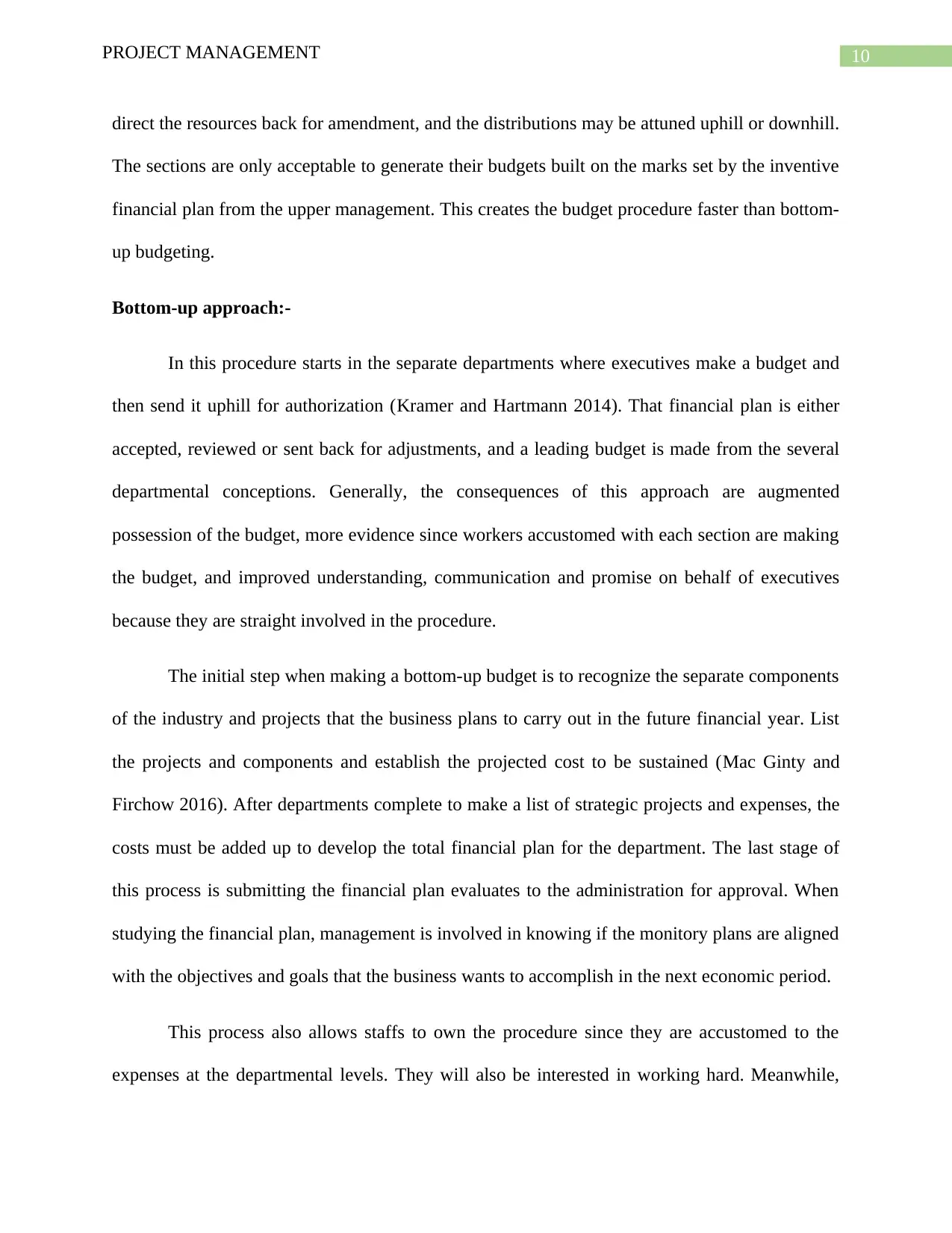
10PROJECT MANAGEMENT
direct the resources back for amendment, and the distributions may be attuned uphill or downhill.
The sections are only acceptable to generate their budgets built on the marks set by the inventive
financial plan from the upper management. This creates the budget procedure faster than bottom-
up budgeting.
Bottom-up approach:-
In this procedure starts in the separate departments where executives make a budget and
then send it uphill for authorization (Kramer and Hartmann 2014). That financial plan is either
accepted, reviewed or sent back for adjustments, and a leading budget is made from the several
departmental conceptions. Generally, the consequences of this approach are augmented
possession of the budget, more evidence since workers accustomed with each section are making
the budget, and improved understanding, communication and promise on behalf of executives
because they are straight involved in the procedure.
The initial step when making a bottom-up budget is to recognize the separate components
of the industry and projects that the business plans to carry out in the future financial year. List
the projects and components and establish the projected cost to be sustained (Mac Ginty and
Firchow 2016). After departments complete to make a list of strategic projects and expenses, the
costs must be added up to develop the total financial plan for the department. The last stage of
this process is submitting the financial plan evaluates to the administration for approval. When
studying the financial plan, management is involved in knowing if the monitory plans are aligned
with the objectives and goals that the business wants to accomplish in the next economic period.
This process also allows staffs to own the procedure since they are accustomed to the
expenses at the departmental levels. They will also be interested in working hard. Meanwhile,
direct the resources back for amendment, and the distributions may be attuned uphill or downhill.
The sections are only acceptable to generate their budgets built on the marks set by the inventive
financial plan from the upper management. This creates the budget procedure faster than bottom-
up budgeting.
Bottom-up approach:-
In this procedure starts in the separate departments where executives make a budget and
then send it uphill for authorization (Kramer and Hartmann 2014). That financial plan is either
accepted, reviewed or sent back for adjustments, and a leading budget is made from the several
departmental conceptions. Generally, the consequences of this approach are augmented
possession of the budget, more evidence since workers accustomed with each section are making
the budget, and improved understanding, communication and promise on behalf of executives
because they are straight involved in the procedure.
The initial step when making a bottom-up budget is to recognize the separate components
of the industry and projects that the business plans to carry out in the future financial year. List
the projects and components and establish the projected cost to be sustained (Mac Ginty and
Firchow 2016). After departments complete to make a list of strategic projects and expenses, the
costs must be added up to develop the total financial plan for the department. The last stage of
this process is submitting the financial plan evaluates to the administration for approval. When
studying the financial plan, management is involved in knowing if the monitory plans are aligned
with the objectives and goals that the business wants to accomplish in the next economic period.
This process also allows staffs to own the procedure since they are accustomed to the
expenses at the departmental levels. They will also be interested in working hard. Meanwhile,

11PROJECT MANAGEMENT
they feel that the management appreciates their input in the business. On the disadvantage, the
departments may calculate budgets that are off-target and not in-line with the business’s
objectives. The financial plan may want to be adapted to reflect the business scope and remove
excessive expenditures.
Question 5:-
What are the common heuristics that can be used to schedule resources in a multi-project
environment? Use example(s) to discuss and comment on their advantages and disadvantages.
Answer:-
Project network systems like as CPM and PERT have been extensively using in the
developing, scheduling, and regulator of massive projects. Modifications of these methods on the
part of specialists and investigators. These have made current actions easier and less expensive to
use, and new expansions in connected computer hardware and software have met the
requirements of such unusual project atmospheres as cost control, the attraction of graphics,
resource distribution, and so on.
Many research breaks away from this convention by delivering a classification course
based on two crucial project summary actions (Pappa et al. 2014). The first size recognizes the
peak location of total resource necessities, and the second measure recognizes the rate of
exploitation of every resource type. The presentation of the rules are categorizing according to
standards of these two actions, and it is revealed that a government presented by this research
implements considerably better on most groups of projects. The Resource Scheduling Method
are many benefits that were applying Network preparation. This can help to achieve on a multi-
projects.
they feel that the management appreciates their input in the business. On the disadvantage, the
departments may calculate budgets that are off-target and not in-line with the business’s
objectives. The financial plan may want to be adapted to reflect the business scope and remove
excessive expenditures.
Question 5:-
What are the common heuristics that can be used to schedule resources in a multi-project
environment? Use example(s) to discuss and comment on their advantages and disadvantages.
Answer:-
Project network systems like as CPM and PERT have been extensively using in the
developing, scheduling, and regulator of massive projects. Modifications of these methods on the
part of specialists and investigators. These have made current actions easier and less expensive to
use, and new expansions in connected computer hardware and software have met the
requirements of such unusual project atmospheres as cost control, the attraction of graphics,
resource distribution, and so on.
Many research breaks away from this convention by delivering a classification course
based on two crucial project summary actions (Pappa et al. 2014). The first size recognizes the
peak location of total resource necessities, and the second measure recognizes the rate of
exploitation of every resource type. The presentation of the rules are categorizing according to
standards of these two actions, and it is revealed that a government presented by this research
implements considerably better on most groups of projects. The Resource Scheduling Method
are many benefits that were applying Network preparation. This can help to achieve on a multi-
projects.
⊘ This is a preview!⊘
Do you want full access?
Subscribe today to unlock all pages.

Trusted by 1+ million students worldwide
1 out of 21
Related Documents
Your All-in-One AI-Powered Toolkit for Academic Success.
+13062052269
info@desklib.com
Available 24*7 on WhatsApp / Email
![[object Object]](/_next/static/media/star-bottom.7253800d.svg)
Unlock your academic potential
Copyright © 2020–2026 A2Z Services. All Rights Reserved. Developed and managed by ZUCOL.





